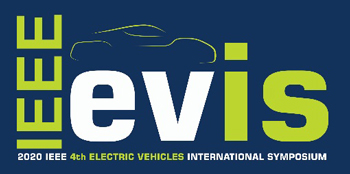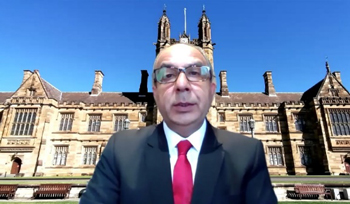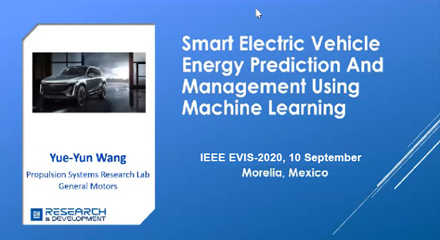|
 The 2020 IEEE 4th Electric Vehicles International Symposium (IEEE EVIS-2020) was held virtually 10 – 11 September 2020, based in Morelia, Mexico. The 2020 IEEE 4th Electric Vehicles International Symposium (IEEE EVIS-2020) was held virtually 10 – 11 September 2020, based in Morelia, Mexico.
Following a series of very successful EVIS conferences in previous years, this year’s symposium was organized by the IEEE VTS Centro Occidente Chapter, and hosted by the Universidad Michoacana de San Nicolás de Hidalgo and the Instituto Tecnológico de Morelia.
IEEE EVIS celebrates its 4th anniversary since the initial event in Morelia 2016, at a time in which interest in electric mobility technology and research as well as our community was increasing and widespread.
With the overall theme, Designing the Future of E-mobility, the aim of the conference was to promote scientific research and technological development of electric vehicles in Mexico. The main actions of this virtual event were:
- To introduce new research lines and initiatives of joint work between the academy and industry
- To promote the development of a Mexican industry of electric vehicles
- To promote the introduction of massive electric transportation based on trains in Mexico
- To disseminate results of research groups
Over the course of the two-day conference, more than 300 participants met virtually in Morelia, Mexico, to exchange ideas and good practices, create and strengthen partnerships and foster collaboration work between the academy and the industry.
Opening Ceremony
The opening ceremony started with the greetings from the Master of Ceremonies, Dr. Nandini Barbosa-Cendejas. The following speakers took the virtual floor to welcome participants to the event:
Dr. Norberto Garcia-Barriga, General Chair of the IEEE EVIS-2020
Dr. Fernando Ornelas-Téllez, IEEE VTS Centro Occidente Chapter Chair
Dr. José Luis Gil-Vázquez, Director of the Instituto Tecnológico de Morelia
 Then, VTS President Abbas Jamalipour delivered a welcome speech, congratulating the organizers of IEEE EVIS-2020 from the IEEE Centro Occidente Section, emphasizing that VTS has made efforts all around the world to continue serving the professional community by organizing virtual conferences and EVIS-2020 is a great example of those efforts. Then, VTS President Abbas Jamalipour delivered a welcome speech, congratulating the organizers of IEEE EVIS-2020 from the IEEE Centro Occidente Section, emphasizing that VTS has made efforts all around the world to continue serving the professional community by organizing virtual conferences and EVIS-2020 is a great example of those efforts.
The official opening of the virtual conference was addressed by Dr. Marco Antonio Landavazo on behalf of the Rector of the Universidad Michoacana de San Nicolás de Hidalgo, Dr. Raúl Cárdenas Navarro.
The technical program of IEEE EVIS-2020 comprised a series of virtual presentations covering a range of areas directly in electric mobility: two plenary sessions, one paper session, one special session on industry activity, a round-table session and a short course.
Plenary Sessions
 The first plenary session examined the application of machine learning for energy prediction and management in electric vehicles. IEEE VTS Distinguished Lecturer Yue-Yun Wang introduced the work carried out to develop machine-learning generated driver models. He explained how these models are developed with collected data to replicate driver behavior and predict drive cycle profiles. The first plenary session examined the application of machine learning for energy prediction and management in electric vehicles. IEEE VTS Distinguished Lecturer Yue-Yun Wang introduced the work carried out to develop machine-learning generated driver models. He explained how these models are developed with collected data to replicate driver behavior and predict drive cycle profiles.
The objective of the second plenary session was to discuss strategies for developing electrified mobility in university campuses. Dr. César Angeles Camacho, research professor from the National Autonomous University of Mexico (UNAM), spoke about the initiative and efforts for implementing a sustainable mobility program at the largest university in Mexico and Latin America.
Each plenary ended with a discussion session with the audience.
Paper Session
Young scientists presented their interesting research results during oral sessions. Authors highlighted important research topics such as “Renewable Energy Based EV Charging Stations”, “Optimal Charging Strategies for the Integration of Electric Vehicles Fleets in Electric Power Networks” and “Smart Metering Blockchain to Electric Mobility.”
Round Table Session
The round table session brought five experts in electric trains to the stage, to speak on the overall theme Towards a Sustainable and Smart Trans-isthmic Dry Canal Project, which refers to the modern trans-isthmus railway corridor between the ports of Salina Cruz, Oaxaca and Coatzacoalcos, Veracruz, in Mexico.
Speakers addressed topics including The Railway of the Isthmus, Interoceanic Corridor Project, Grid Codes: Goals and Challenges and Electric Traction and Electric Power Systems, as well as taking a look into the history of this project. The challenges involved with this project and ideas for overcoming them were also included in the round-table debate.
The development of the trans-isthmic dry canal is centered on the renovation and expansion of the existing railways, port terminals and airports. However, a dry canal based on traditional, unsustainable rails will face many challenges in the future such as scarcity of natural resources and undesirable environmental impacts such as CO2 emissions.
Electricity can be railway system’s main power supply. The carbon intensity of railway infrastructure can be further reduced by increasing the share of renewable energies. In this context, the incorporation of SmartGrid technologies allows the recovery of a train’s braking energy, and integrates local renewable production and storage systems. Consequently, this approach ensures high-quality train supply, increases the energy efficiency and reduces energy cost.
Short Course
Participants took part in a 20-hours intensive course, during which they accessed expert knowledge on the “Design of an Electricity Energy Meter Using ESP32 and Arduino.” Electricity energy meters—based on a Wi-Fi platform, and suitable for installation in a house, an electric vehicle or a battery—are key elements to monitor and predict energy consumption continuously and from anywhere in the world.
Closing Ceremony
In his closing speech, Dr. Norberto Garcia took the opportunity to reflect on the last two days, remarking on how the delegates learned together, and from each other, encouraging participants to take one new idea or action home with them with enthusiasm and motivation to implement it. Finally, he invited the audience to join the next IEEE EVIS to take place in 2022. |